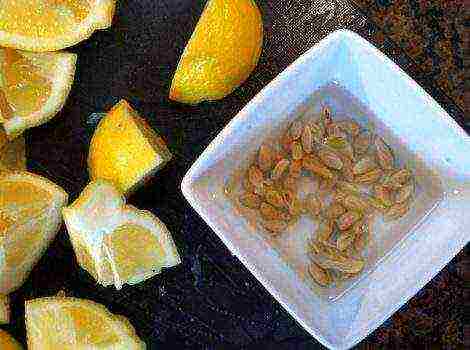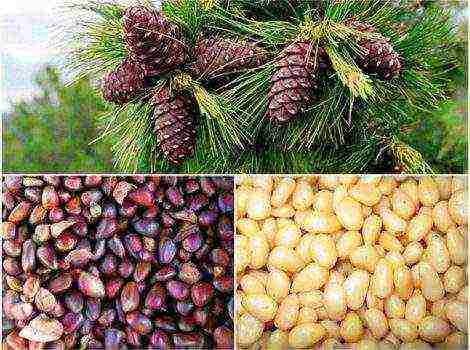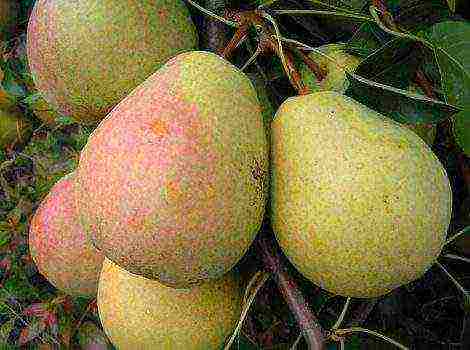Content
- 1 When is the best time to plant fruit tree seedlings in spring or autumn?
When is the best time to plant fruit tree seedlings in spring or autumn?
A transplant for a plant is a traumatic operation, which is best done during the period of natural rest, then it takes place practically "under anesthesia." This is especially true for seedlings with bare roots.
Most fruit trees are best planted in a permanent place after the completion of vegetation processes - in the fall... Roughly, this is a month before the freezing of the topsoil. Some trees are best planted in spring. Let's talk in more detail about the timing of planting seedlings of fruit trees, how to fertilize and properly care for them.
When is the best time to plant fruit trees - in spring or autumn?
Determining that a tree is ready for replanting is very simple. The main criterion is that the tree has dropped half of the leaves... They are guided when planting winter-hardy varieties of pears and apple trees, as well as all berry bushes.
Apple and pear varieties with insufficient frost resistance, as well as all stone fruits (cherry, sweet cherry, plum, apricot and peach), best planted in spring. Moreover, it is necessary to do this as early as possible - until the moisture has left and the buds have not blossomed.
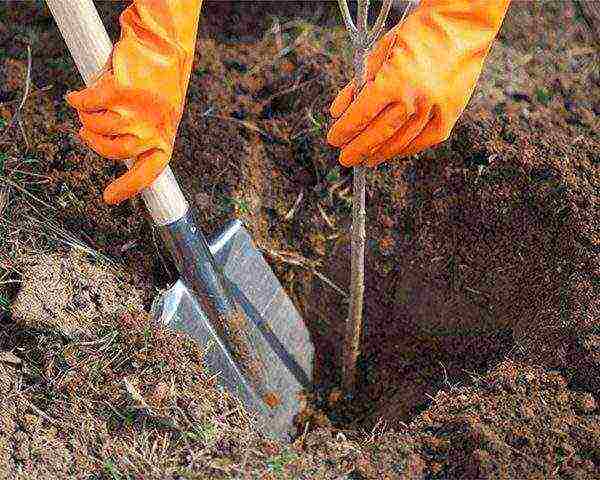
In any case, planting pits are prepared in advance - for spring planting, for example, from autumn (August - September). The deadline for the preparation of pits is 2 weeks.
How to choose a seedling for planting in the Moscow region and other regions
In order not to throw money down the drain and grow a really productive fruit tree, the choice of a seedling should be approached with understanding and responsibly.
Choosing a seedling with an open root system
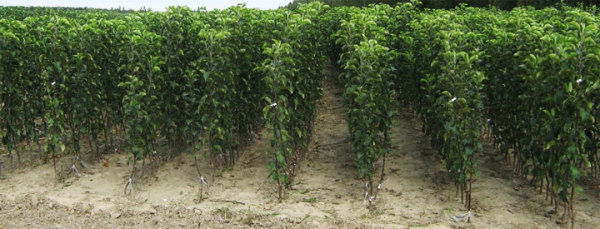
- Primarily, the variety must be zoned.
- To increase the likelihood of purchasing the desired variety, buy them in a specialized nursery, and not "from the hands" by the road.
- Roots should be no shorter 25 centimetersfresh and undamaged. The more branched thin roots, the higher the probability of success.
- On the roots there should be no growths Is a symptom of root cancer. The root cut should be white.
- Carefully inspect the trunk for damage to the bark.
Wrap the roots with damp burlap or newspaper in several layers. If the seedling is still dry, immerse it in water for a day or two until the bark regains a fresh look.
You can treat the roots with stimulants just before planting. (Kornevin or Heteroauxin) according to the instructions.
Take special care to ensure that the roots are not chafed. These areas are likely to rot - they must be carefully removed to the healthy part.
Choosing a seedling in a container
Such planting material is more expensive.If you choose it correctly, you can plant it at any time convenient for you. The survival rate is guaranteed ...
How not to be mistaken
The easiest way to check how long a tree has been growing in a pot is to gently lift the plant by the root part. If the earthen clod is taken out along with the roots, you need to buy - the seedling "lives" in the container for a long time.
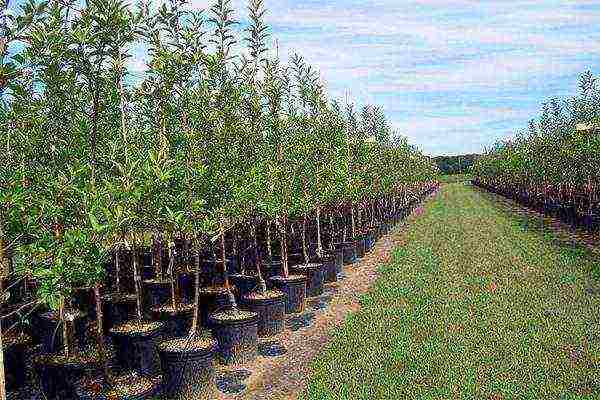
Additionally, it will help you make sure that you have made the right choice. root sprouted through a hole in the bottom of the container.
The tree is installed in a prepared planting hole without violating the integrity of the earth clod. Water and cover with prepared soil mixture without deepening the seedling.
Rules for planting a seedling in a garden plot at different times of the year?
The choice of a place for planting a fruit tree - it is made once and for all, success or disappointment depends on this choice. If the place turns out to be unsuitable for a fruit tree, after a few years it will be impossible to correct the error.
Choose a sunny place, sheltered from the wind, for landing... The close location of groundwater is unacceptable - a tree can successfully develop for 5-7 years, and when its roots reach the aquifer, it will die from decay. At this age, replanting a tree is already incredibly difficult.
Preparatory activities
Even the choice of soil is not so critical for planting a fruit tree. By improving the soil structure and applying the right fertilizing, almost any area is suitable for gardening.
Landing pit preparation
Even in the case of fertile black soil, it is necessary to start planting a tree with the preparation of the planting pit... It must be dug out at least a month before planting the seedling. During this time, the dug-up earth will have time to pack. This is a factor of extraordinary importance - there will be no problems with the correct deepening of the root collar of the seedling.
Where is the root collar?
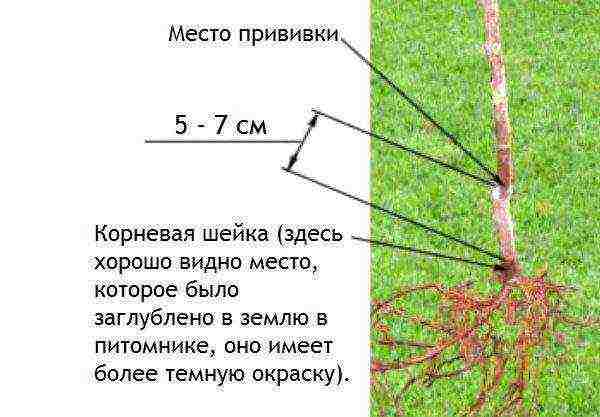
It will not be superfluous to clarify what this "root collar" is. Often, inexperienced gardeners take the place of grafting by the root collar, and as a result, they deepen the seedling an extra 10 centimeters. Actually, this is the area where the trunk goes to the root... At this point, the dark color of the root passes into the lighter bark of the trunk.
After planting, the seedling should not lack nutrients, at least until it takes root. At this stage, very often with the best intentions, gardeners "overfeed" the seedlings with fertilizers.
It is especially dangerous for young plants to add fresh organic matter and too much mineral fertilizers to the pit.... These two extremes act equally depressingly on soil microorganisms, namely, they help the roots of the seedling to absorb nutrients from the soil and air.
- For a conditioned seedling 1-2 years old, it is necessary dig a hole about 80x80 centimeters and the same depth. In the process of digging a hole, fold the upper, more fertile layer separately from the lower one. Remove all stones and roots of perennial weeds. The bottom of the hole must be dug onto the bayonet of the shovel.
- To the bottom of the pit to improve the water balance is desirable sprinkle last year's leaves, house debris, wood ash... This will not only be good drainage, but also an excellent additional tree feeding.
- Into the pit add 2 buckets of compost or humusand proceed as follows.
- One bucket is mixed with the more fertile soil of the upper layer and poured into the bottom of the pit.Place a seedling on this mound, spread its roots and pour the second part of the compost directly onto the roots. At the same time, shake the seedling so that there are no air voids that are not filled with soil.
- Watering welltons (at least 2 buckets of water).
- The pit is filled up to the top... For this, only the upper fertile layer is used.
- From the bottom layer of the earth form a root hole around the trunk circle.
- Water again into the formed hole and cover it with mulch (peat, rotten sawdust, foliage, wood chips), this not only preserves water, but also prevents a dense crust from forming.
Planting scheme for fruit trees and shrubs
The planting density of trees depends not only on the species, but also on:
- type of root stock of a seedling,
- method of further formation,
- features of the site layout.
The most common mistake novice gardeners make is planting too tight... It is very difficult to see trees at least 2.5 meters in height in the twigs of one-year-old seedlings after 10 years. The recommended planting pattern for shrubs and trees is given below.
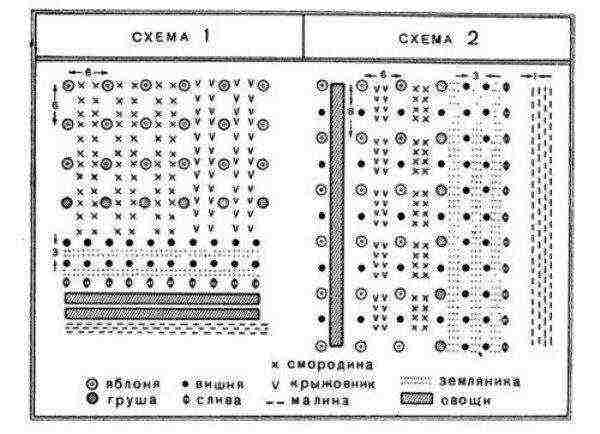
Saplings of apple and pear trees on vigorous rootstocks are placed at a distance 5 meters, medium-sized - 3.5-4 meters, dwarf - 2.5-3 meters... Columnar forms can be planted even after 0.5 meters in a row.
No less distance should be laid when planting seedlings near the house, especially this applies to tall forms of fruit, and especially pay attention to the location of the walnut - over time it will be a 10-meter spreading tree.
Caring for a newly planted tree in the spring-autumn period
After planting a young tree, in addition to feeding the seedling, there must be proper follow-up care for it. The first time after planting most of all the seedlings need watering. Among experienced old-school gardeners, there is an opinion that seedlings need watering for 2 years, even if they have taken root successfully. You need to water even trees planted in autumn until the very frost... Only then will the tree grow strong and healthy.
No matter how great the desire to try the harvest from a young tree, the first flowers must be removed. This especially applies to the first year after planting, otherwise the tree will give all its strength to the first few fruits, and the root system and a developed crown will not be able to grow.
In addition to watering, a young tree requires preventive measures to protect against pests and fungal diseases.... Do not ignore them during every garden treatment. The loss of branches and leaves from an invasion of pests or any disease can be critical for a young tree.
Preparing young trees for winter includes:
- mulching trunk circle,
- whitewash for the prevention of sun and frosty winter burns,
- rodent protection and hares.
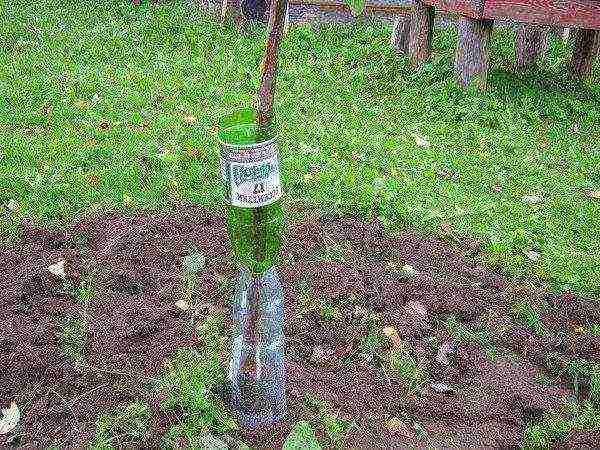
The mulching layer must necessarily cover the near-trunk circle, not only in the summer to preserve moisture in the root zone. Mulch is especially necessary in the autumn-winter period. Even in the conditions of the Central strip and the Moscow region, the roots of a seedling of a tree or shrub can suffer from freezing, especially if the snow cover is light.
Fertilizers and fertilizing for the fruit tree
A well-stocked planting pit provides nutrition for the planted tree for 2 years. In practice, it only needs watering.
Top dressing of the garden is carried out according to the well-established rule:
- in the spring - nitrogen and organic fertilizers,
- in the fall - potash and phosphorus.
Fertilization is usually carried out in near-stem circles in early spring (1) or autumn (2).
Fertilizers are applied to the root zone at the rate of 1 hundred square meters of the garden:
- organic 300-500 kg (every 2-3 years),
- inorganic N: P: K in proportions of 1.5: 1: 0.6 (calculated per kg of chemically pure substance).
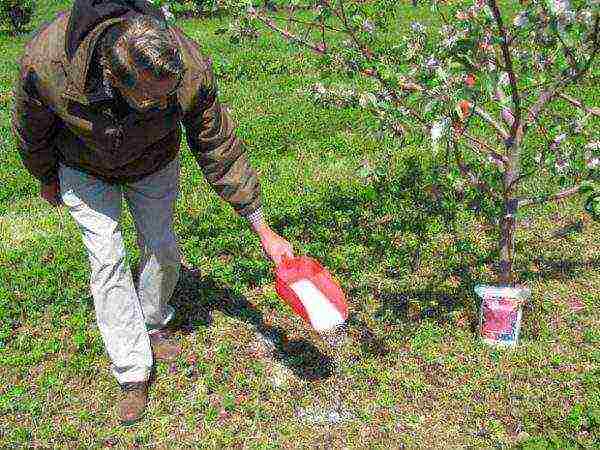
In addition to root dressing, gardeners often practice leaf dressing. In this case, the so-called "tank mixtures" are used - joint solutions of chemical preparations, for example, against pests and a complex of foliar dressings.
Another "plus" of such processing - the consumption of fertilizers is minimal. For example, for nitrogen fertilizing, a solution of 1 tablespoon of nitrate per 1 bucket of water is prepared.
The only inconvenience is that it cannot be processed just before the rain.
Conclusion
The optimal time for planting fruit trees depends on many factors:
- From the climatic conditions of your region.
- From the winter hardiness of the seedling.
- From the type of seedling - container or "bare root".
In order not to get confused, Ukrainian gardeners have an old rule, which is all the more obligatory. for colder regions - all stone fruits are planted in spring, pome fruits - in autumn.
